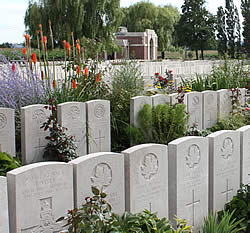Bedford House Cemetery
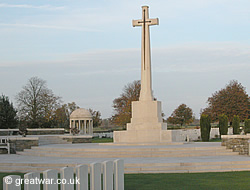
|
There are 5,139 Commonwealth casualties from the First World War buried in the site of Bedford House Cemetery. Of these casualties 2,194 are identified burials. Special memorials commemorate those Servicemen who are believed to be buried here but their marked graves were destroyed and could not be found. There are two German servicemen buried here.
69 British servicemen of the British Expeditionary Force who fell in the vicinity here in May 1940 during the Second World War are also buried in this cemetery site.
Château Rosendal - Bedford House
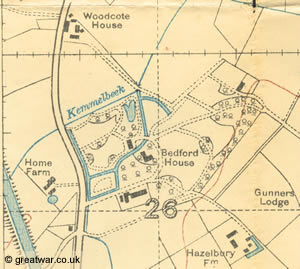
|
The pre-war Château Rosendal was located south of Ypres in grounds made up of areas of woodland, moats and a lake. The Kemmelbeek stream ran along the northern boundary of the château grounds.
The château was in Allied-held territory behind the Allied Front Line for the duration of the war. From the time when the British took over this southern sector of the Ypres Salient from the French Army in the early weeks of 1915 through to the autumn of 1918 the main house, its various outbuildings and grounds were used for headquarters, field ambulances and burial sites. The château was renamed by the British as Bedford House.
The detailed section from a British Army trench map dated August 1916 shows the layout of the grounds, the moats, woodland and lake. The main road from Ypres to St. Elooi is seen on the left of the site, running from north to south. The Ypres-Comines canal, as it was at that time, can be seen on the left of that road. Just to the south of the Bedford House site the canal made a turn to the east and crossed under the road at Lock No. 8.
Over the period of the four years the house and its grounds were shelled by German artillery. The Château Rosendal and its surrounding parkland were destroyed.
The Cemetery
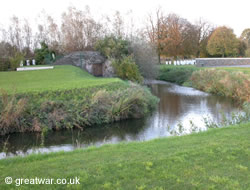
|
The site of the British and Commonwealth military cemetery named Bedford House was used by the British Army from 1915 through to the end of the war. By the time the war was over there were “enclosures” containing graves in various numbers on this site. With the development of the cemetery after the war, and graves being brought into the site from burial sites and battlefield burials around the area, the Bedford House Cemetery now consists of four Enclosures, these being numbered Enclosure Numbers 2, 3, 4 and 6.
Enclosure No. 1
After the Armistice the group of graves in Enclosure 1 was moved to St. Jean, north-east of Ypres into White House Cemetery.
Enclosure No. 2
The site at Enclosure No. 2 was started as a burial ground in December 1915. It was in use during the war until October 1918. After the Armistice a further 400 graves were moved into this Enclosure from two British military cemeteries close to the Ypres town centre, the École de Bienfaissance Cemetery and the Asylum Cemetery.
Enclosure No. 3
The site at Enclosure No. 3 was in use from February 1915 to December 1916.
Enclosure No. 4
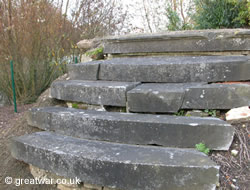
|
The site at Enclosure No. 4 was in use from June 1916 to February 1918. Many of the casualties buried during that time were serving inm this area with the 47th (London) Division. After the Armistice a further 3,324 casualties were brought to this Enclosure. They had originally been buried or had been missing in action on the battlefields around this site. Many of these re-burials remain unidentified.
Enclosure No. 6
Some twenty years after the Armistice of November 1918 a sixth enclosure was established for casualties who were discovered and brought in from the fields in the area as the great task of battlefield clearance was underway.
Casualties from the battles in the vicinity during the British Army's fighting withdrawal to Dunkirk in May 1940 are also buried in this enclosure. They died in the area of the Ypres-Comines railway line and canal bank.
Design
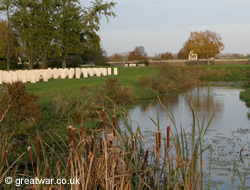
|
Wilfred Clement Von Berg was responsible for the design of this cemetery. He was 19 years old in the summer of 1914 when war was declared. He enlisted and was commissioned as a 2nd Lieutenant in the 5th Battalion (City of London) London Regiment (also known as the London Rifle Brigade). He arrived in the theatre of war in France & Flanders in September 1915. During his military service in the Great War Wilfred served as an acting Captain and Adjutant, being awarded the Military Cross for gallantry.
Before the war broke out Wilfred had started to study to be an architect and his training was interrupted when he joined the British Army. After the war he took up a post as an assistant architect with the Imperial War Graves Commission (now named the Commonwealth War Graves Commission). He designed more than 30 of the British and Commonwealth military cemeteries.
Von Berg's design of the cemetery incorporates the moats which were in the Château Rosendal parkland before it was so badly damaged. A set of stone steps can be found in the cemetery, being almost all that remains of the old château and its pre-war buildings.
Casualties
Fred Storey, Aged 16
One of the youngest casualties in Bedford House Cemetery with a known age of 16 years is Private Frederick Storey, Service Number 489375. He was serving with the 18th Battalion (Western Ontario Regiment), Canadian Infantry when he died on 30th June 1916.
According to the Attestation Paper when Fred signed up for the Canadian Expeditionary Force on 28 December 1915, he gave his date of birth on the front of the form as 18 February 1897 (1). On the reverse of the Attestation Paper his stated “apparent age” is clearly written as 18 years and 4 months. This cannot be correct as this age would imply that he had been born in August/September, and not February as he stated on the front of the form. In any case, he is listed on the Commonwealth War Graves Commission register as aged 16 at the time of his death in June 1916.
On the form he gives his occupation as Pattern Maker. He gives his father's name as his next-of-kin, living at 16 Campbell Road, Halifax, Nova Scotia. Some personal details about Fred that we can presume to be accurate from the Attestation Paper is that he was 5 feet 7 and a quarter inches tall, he had grey eyes and dark brown hair. Having signed up on 28th December 1915 Frederick again signed the Attestation Paper under oath on 4th January 1916. Within a matter of weeks he was in Belgium with the 18th Battalion and he died on the Western Front almost exactly six months to the day after he had signed his Attestation Paper.
From 24 to 28 June the 18th Battalion (Western Ontario Regiment) had been in reserve at the Bedford House location. On the evening of 28 June the battalion moved forward to relieve the 20th Battalion Canadian Infantry in the Front Line trenches to the east of Bedford House. The War Diary for the 18th Battalion states that on 28 June three Other Ranks were wounded and on 29 June two Other Ranks were wounded. No casualties either wounded or killed are listed for 30 June.(2)
It is considered, then, that Fred was one of the wounded Other Ranks on 28 or 29 June and that he was cared for at the Field Ambulance at Bedford House where he died. Fred Storey's grave is located at Enclosure No. 4, Plot I, Row M, grave reference 9. As very many of the graves in Plot I around his grave have the month of June 1916 as the date of death, this indicates that it is likely he died at Bedford House in June 1916 and that he was not one of the reburials brought to this place after the war. He and the men buried around him in Enclosure No. 4 Plot I were the first burials in this Enclosure when it was begun in June 1916.
Fred's mother and father are given as Alice and Robert James Storey of Geary Street in Dartmouth, Nova Scotia.(3)
Location of Bedford House Cemetery
Rijselseweg, 8902 Ieper, Belgium
Latitude 50.827049; Longitude 2.888147
Bedford House Cemetery is located approximately 2 kms south of Ypres (Ieper) on the N336 Rijselseweg. It is situated on the east side of the road between Ieper and St. Elooi.
Parking
There is a parking layby at the entrance to the cemetery. Visitors should take care as vehicles may be travelling fast along this road.
Related Topics
Cemeteries in the Ypres Salient
See our list of cemeteries and their locations.
Cemeteries in the Ypres Salient
British Army WW1 Trench Maps
Find out more about the maps used by the British Army during the 1914-1918 war on the Western Front and where you can see them:
Acknowledgements
(1) Library & Archives Canada, Soldiers of the First World War CEF, Reference: RG 150, Accession 1992-93/166, Box 9362 - 6, www.collectionscanada.gc.ca
(2) 18th Battalion Canadian Infantry War Diary June 1916, Library & Archives Canada, Reference: Online MIKAN no. 1883227 Item 116, www.collectionscanada.gc.ca
(3) The Commonwealth War Graves Commission (CWGC)
Some of the cemetery description and history has been sourced by kind permission of The Commonwealth War Graves Commission (CWGC). For more information about the cemeteries and the work of the commission visit the CWGC website:
Website: www.cwgc.org
See our page on the CWGC and the information available to family historians:

